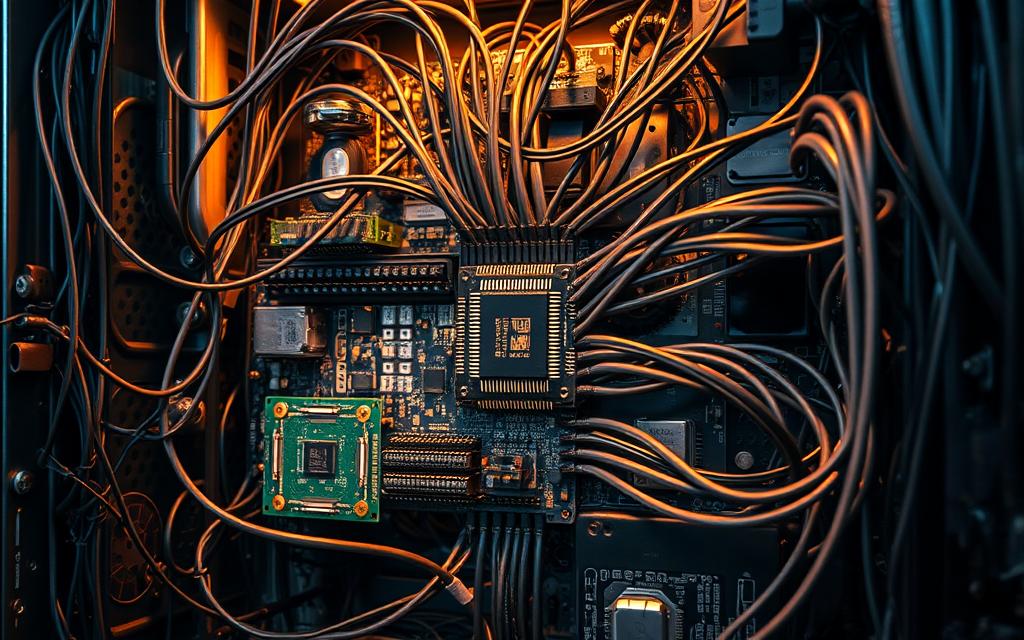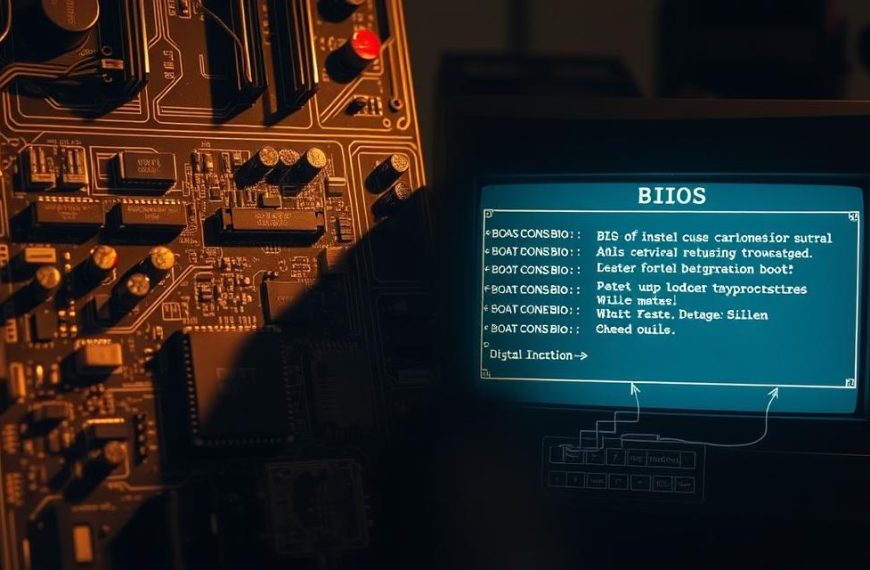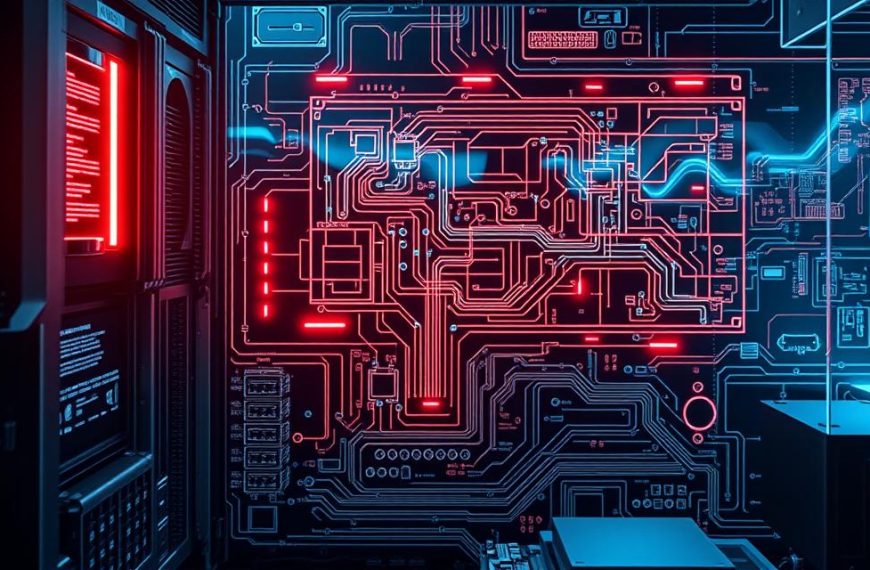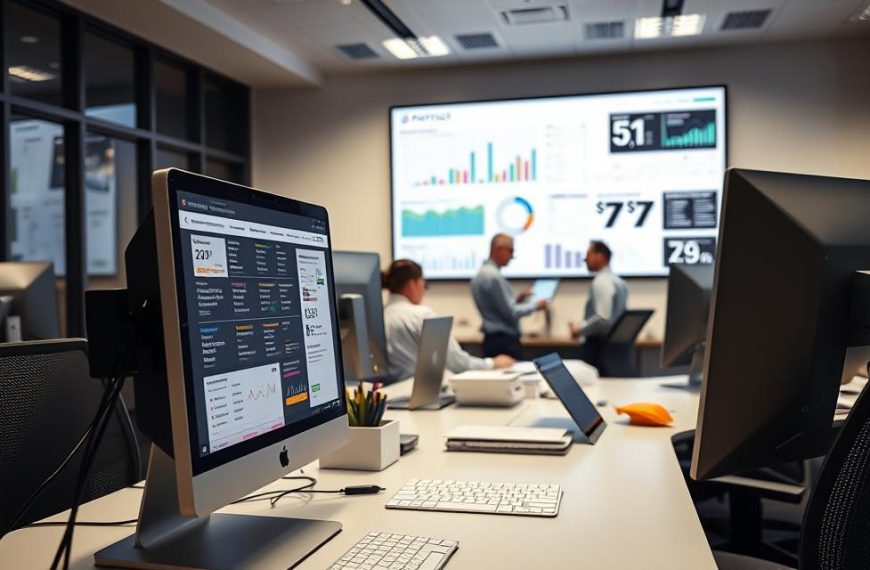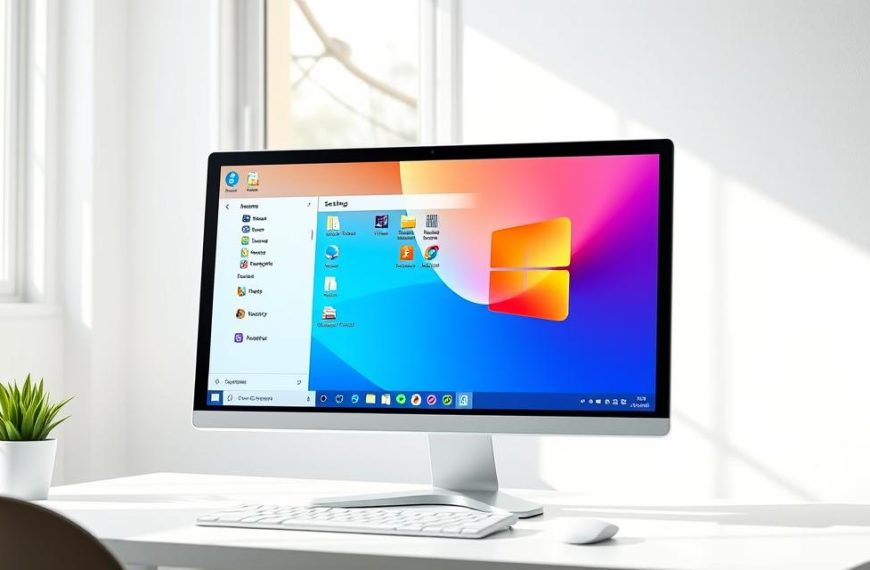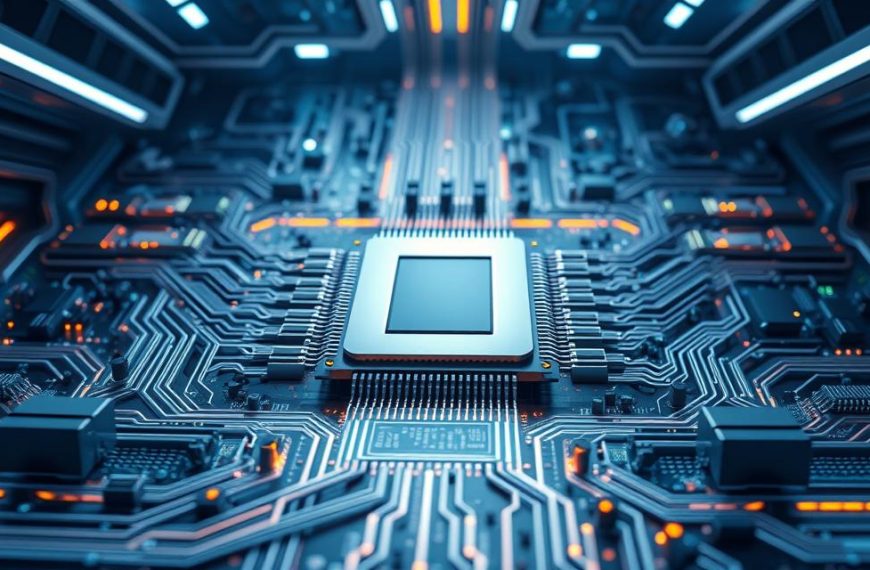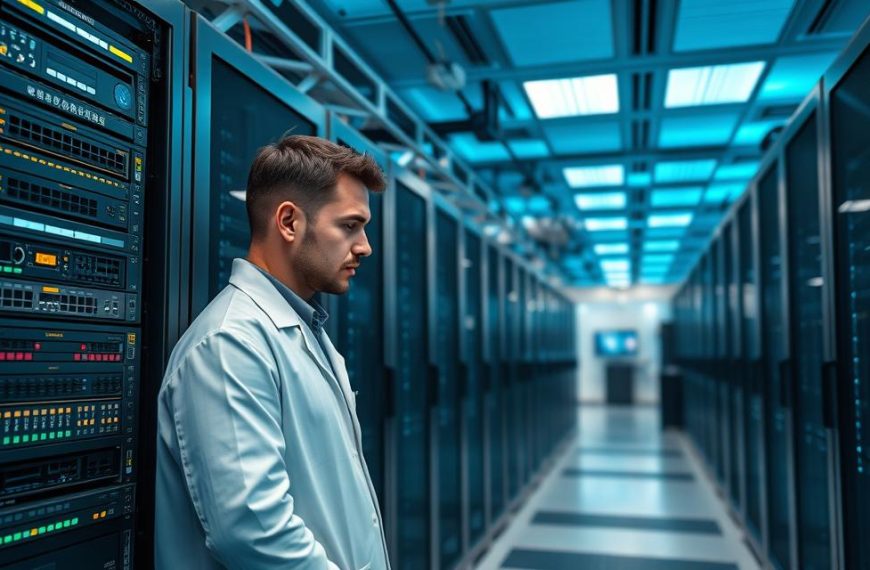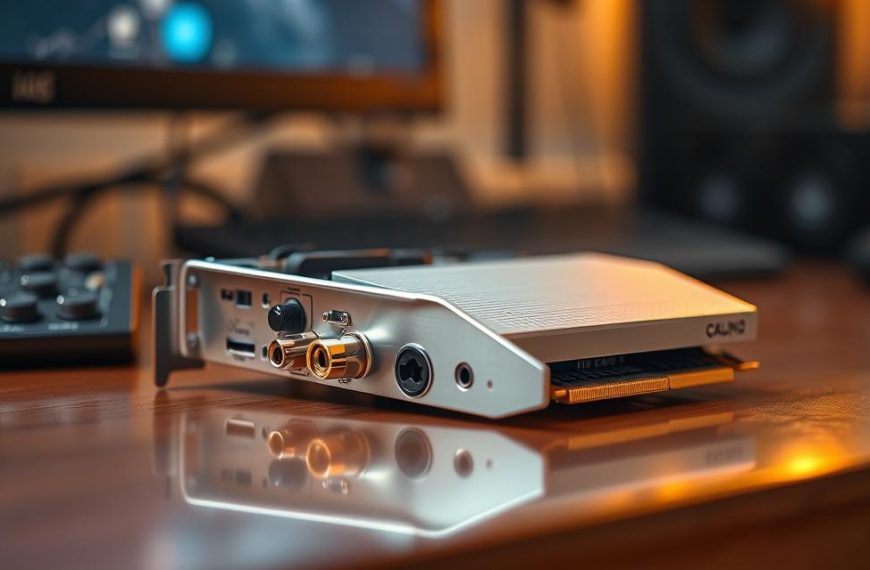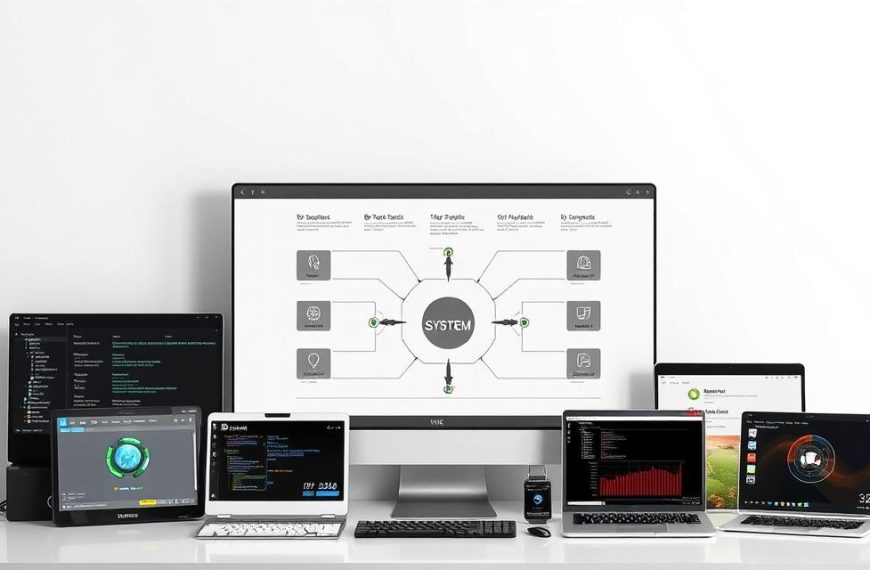Modern computing is like a symphony of parts working together. It’s not just about individual parts. It’s how they work together to process information.
This computer system definition is all about working together. A processor, memory, and devices talk to each other through special paths.
Each part needs the others to work well. The motherboard connects everything together, making a strong team.
Knowing how this computing system explained helps us see why problems can spread fast. It shows how careful design makes the whole system stronger than its parts.
Defining a System and Its Core Characteristics
To understand how a computer works as one unit, we need to know what makes a system. This knowledge helps us see how different parts work together smoothly.
The Concept of a System in Computing
In computing, a system is a group of parts that work together to achieve goals. These parts, whether they are hardware or software, form a single unit. They don’t work alone.
Key Characteristics: Interdependence, Purpose, and Boundaries
Three main traits define any computing system. These traits help create efficient and reliable technology environments.
Interdependence of Components
The component interdependence in computers means that parts like the processor and memory work together. As one source says, “The way components connect and work together affects the system’s performance.” This means that a problem in one part can impact others.
Common Purpose of the Whole
Every computer system has one main goal: to process information. This goal guides how all parts work together. It helps them complete tasks efficiently.
Defined System Boundaries
The idea of system boundaries computer experts talk about includes physical and logical limits. These limits separate internal parts from external devices. For example, address buses help set boundaries between memory and input/output devices. This makes it clear how the system works.
Why is a Computer a System: The Central Argument
Computers are top examples of complex systems in today’s tech world. Their strength comes from how well hardware and software work together. This teamwork is key to their ability to process information.
The Synergy of Hardware and Software
The magic of computing is in the partnership between hardware and software. Hardware gives the computer its physical parts, like processors and memory. Software brings the brain, guiding these parts.
This hardware software synergy means both are needed to work. A fast processor needs software to tell it what to do. Without software, even the best hardware is useless.
Computers work through a cycle of feedback. Hardware runs software, and software adjusts to hardware’s abilities. This lets computers handle different tasks well.
Input, Processing, Output: The Fundamental Cycle
Every computer task follows a pattern called the input processing output cycle. This ensures data is handled well from start to finish.
The cycle starts with data from users or other systems. The computer then processes this data as told by software. Lastly, it gives back results to users or saves them for later.
The Role of Input Devices
Input devices connect users to computers. Items like keyboards and mice turn human actions into digital signals. Without them, computers can’t get the data they need.
These devices start the computer’s work by giving it raw data. Without good input devices, computers can’t do much.
The Central Processing Unit’s Function
The CPU is the computer’s brain. It executes instructions through a cycle of fetching, decoding, and executing. This cycle happens millions of times a second.
As one source explains:
“The processor reads in instructions and data, writes out data after processing, and uses control signals to control the overall operation of the system.”
This cycle is key to the CPU’s work. It fetches instructions, decodes them, executes them, and stores the results. The CPU does this non-stop, making it the heart of the computer.
Output Devices and Data Storage
Output devices show the results of processing. Monitors show visuals, printers print, and speakers play sounds. They finish the cycle by showing what the computer has done.
Storage keeps data safe for later use. Hard drives, solid-state drives, and cloud storage make sure data is not lost. They keep data safe even after processing is done.
| Component Type | Primary Function | Common Examples | System Importance |
|---|---|---|---|
| Input Devices | Data collection and entry | Keyboard, mouse, scanner | Initiates processing cycle |
| Processing Units | Instruction execution | CPU, GPU, APU | Performs computational work |
| Output Devices | Result presentation | Monitor, printer, speakers | Completes processing cycle |
| Storage Systems | Data preservation | HDD, SSD, cloud storage | Enables data persistence |
Computers are true systems because of how they work together. Each part relies on others to do its job. This teamwork makes computers powerful and useful.
The Hardware Subsystems: Physical Components Working Together
Software gives the instructions, but it’s the hardware that makes the computer work. These parts work together to process information and do tasks. They are all connected in a way that makes the computer run smoothly.
The Central Processing Unit: The Computational Brain
The CPU is like the brain of the computer. It does billions of tasks every second. It’s in a special socket on the motherboard and handles all the math and input/output operations.
Modern CPUs get very hot because they work so hard. They need good cooling to avoid overheating and damage.
“The central processing unit (CPU), also called a processor, is located inside the computer case on the motherboard. It is sometimes called the brain of the computer.”
Memory Hierarchy: From Registers to Secondary Storage
The memory hierarchy organises storage by speed, capacity, and cost. It has different levels to keep data fast and have enough space for everything. This makes the computer efficient and effective.
Random Access Memory’s Vital Role
RAM is like the computer’s desk. It holds programs and data that the CPU needs right away. Unlike hard drives, RAM loses its data when the power goes off. This makes it essential for quick tasks.
Storage Devices: HDDs and SSDs
HDDs and SSDs store data for a long time. HDDs are cheaper and hold more, but are slower. SSDs are faster and have no moving parts, but are more expensive.
The storage hierarchy puts fast, expensive data first. This makes the computer run better and more efficiently. It’s all about balancing speed and storage.
Motherboard: The Central Nervous System
The motherboard does more than just hold parts together. It connects everything in the computer. It’s like the nervous system, making sure all parts talk to each other.
The motherboard has special slots for adding new features. It also has a chipset that manages data flow. This design makes the computer work smoothly.
| Component | Primary Function | Interaction Method |
|---|---|---|
| CPU | Instruction processing | Direct socket connection |
| RAM Modules | Temporary data storage | Memory slots |
| Storage Drives | Permanent data retention | SATA/NVMe interfaces |
| Expansion Cards | Additional functionality | PCIe slots |
The motherboard connects the CPU, memory, and other parts. It makes sure the computer works well together.
The Software Layer: Instructions That Bring Hardware to Life
Hardware gives us the physical parts, but software makes them work. It turns these parts into a real computer system. This digital world lets computers do many things without changing their parts.
Operating Systems: The Master Coordinator
The operating system is at the core of every computer. It acts as the operating system coordinator. This software connects hardware and apps, making sure everything works well together.
Resource Management and Allocation
The operating system is great at resource management computing. It shares important resources like processor time and memory between programs. It also controls how data moves in and out of the system.
This smart sharing lets many apps run at once without problems. The system stays stable, even when it’s doing lots of things at once.
Providing a User Interface
Operating systems also make it easy for people to use computers. They offer interfaces like desktops or command lines. These interfaces turn what we type or click into actions the hardware can do.
This layer hides the complex details of hardware. It gives us control over the computer’s power.
Application Software: Performing Specific Tasks
Application software shows what computers can do. It includes things like word processors and web browsers. These apps use the operating system to do their jobs.
Software lets computers do many things, unlike fixed systems. As one source says: “The software-based programming can be easily manipulated to run different tasks without requiring any physical changes. It only needs instruction in codes, an instruction interpreter, control signals, and software necessary for said task.”
This flexibility means the same hardware can be used for different tasks. It depends on the apps installed and running.
Communication Pathways: Buses and Interfaces
Computers work well because of good communication paths. These paths let data, instructions, and control signals move between parts.
Data Buses: The Information Highways
Data buses are key for computer communication. They are shared paths for info between the processor, memory, and devices.
Old bus systems had problems because they were shared. This led to slow speeds. New designs have fixed these issues.
As one technical source explains:
“A bus is a communication pathway connecting two or more devices. A bus that connects major computer components (processor, memory, I/O) is called a system bus.”
Expansion Slots and Peripheral Connections
Expansion slots add new features to computers. They let users add special parts not in the original setup.
New connection tech has made data transfer faster and more reliable. Modern interfaces are much better than old ones.
PCI Express for Internal Components
PCI Express is a big step forward in internal connections. It uses direct links for each device, unlike old shared buses.
This design avoids slowdowns and offers more bandwidth. It’s great for graphics cards, network adapters, and storage.
Another source notes:
“Modern architectures, such as point-to-point links and PCI Express (PCIe), address these issues. PCIe, for example, uses individual lanes to connect devices like GPUs directly to the CPU.”
USB and Thunderbolt for External Devices
USB and Thunderbolt have changed how we connect to the outside world. They support many devices, from storage to input devices.
Thunderbolt is very fast. It handles data, video, and power in one small connector.
| Interface Type | Primary Use | Maximum Speed | Key Features |
|---|---|---|---|
| PCI Express 4.0 | Internal components | 16 GT/s per lane | Point-to-point architecture |
| USB 3.2 Gen 2 | External peripherals | 10 Gbps | Backward compatibility |
| Thunderbolt 4 | High-speed external | 40 Gbps | Daisy-chaining support |
These paths show the advanced engineering in today’s computers. New tech keeps computers up to speed with demanding tasks.
Real-World Examples of System Failure and Interdependence
Understanding computer systems is clearer when we see what happens when parts fail. These examples show how hardware and software depend on each other.
Hardware Component Failure Effects
When parts break, the whole system is affected. These hardware failure effects show how connected computer systems are.
RAM Failure Consequences
Random Access Memory is your computer’s temporary workspace. If RAM fails, it can’t hold data well.
The main RAM failure consequences are:
- System instability and frequent crashes
- Data corruption during processing
- Sluggish performance with many programs
If your RAM is low, your computer will be slow with many programs open.
Storage Device Failures and Data Loss
Storage devices are your system’s long-term memory. When they fail, it’s a big problem.
Storage failures lead to:
- Permanent data loss from corrupted sectors
- System inoperability when boot files are affected
- Complete system failure if critical components can’t be accessed
As one expert says, “When you save a file, the data goes to the hard drive, which is long-term storage.” This shows how important storage reliability is.
Software Issues Affecting Hardware Performance
Software problems can cause big software hardware performance issues. This shows that software can affect hardware.
| Software Issue | Hardware Impact | System Consequences |
|---|---|---|
| Driver Conflicts | Components become non-functional | Peripheral devices stop working |
| Memory Leaks | RAM becomes overwhelmed | System performance degrades over time |
| Incompatible Software | Hardware operates suboptimally | Reduced efficiency and possible damage |
These examples show that computer systems are delicate ecosystems. Both hardware and software must work together for the best performance. If one part fails, the whole system is affected.
Conclusion
A computer is a complex system where all parts work together. This summary shows how hardware and software work together to process information well. The CPU, memory, storage, and peripherals form a single unit with a shared goal.
The performance of a system relies on how well its parts work together. If one part fails, the whole system is affected. This is why fixing problems needs a complete view, not just looking at one part.
Understanding computers as integrated systems is key for making them better and more innovative. The way components interact affects the system’s ability. Knowing this is vital for using and improving computer technology.
